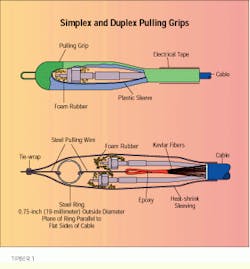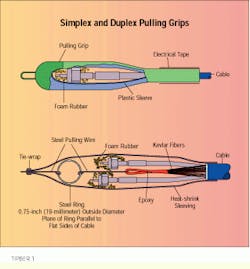Lisa Bechtold
Berk-Tek Inc.
Problem
Even though fiber-optic cable is advertised as being more robust than Category 5 unshielded twisted-pair copper cable, pulling it in horizontal cable runs in premises applications requires some special considerations. These considerations are familiar to installers who specialize in optical fiber cabling, but may be unknown to the contractor who has dealt primarily with copper cabling. Failing to follow such a procedure can result in broken fibers or high-loss links.
Solution
Adherence to a simple cable-pulling procedure, including the use of specific tools designed for the purpose, can assist you in handling fiber-optic cables in premises wiring. This procedure assumes the cable has not been connectorized prior to pulling.
Procedure
1) Inspect the cable run to ensure there are no sharp bends or corners that exceed the minimum bend radius of the fiber. (The minimum bend radius for installation is different from the long-term minimum bend radius; both values should be specified by the manufacturer.)
2) In many runs, if the pulling distance is short enough and the pathway straight enough, fiber-optic cable can be pulled by hand, without the use of special equipment. However, first make sure the pull does not exceed the tensile-loading limit established by the manufacturer for installation. (This value is not to be confused with the long-term tensile-loading limit.) The load must be applied to the strength-bearing members of the cable; otherwise, the jacket may be stretched in the pull and the fiber can bunch up beneath the jacket when tension is released. A simple way to avoid this is to tie a knot at the pulling end of small fiber-optic cables.
3) When additional mechanical force is needed for a pull, use external pulling grips. This device locks onto and tightens around a cable as a tensile load is applied. The load is applied to the strength members of the cable rather than the optical fiber, itself. The pulling end of the grip is a loop or eye that permits attachment of a pulling tape or rope.
4) With some cables, such as outside-plant cable, it may be necessary to attach the pulling grip to strength members that surround the cable core as well as the outer jacket. This is done by sliding the grip past the end of the cable and then cutting the cable jacket back to expose the strength members. Use friction tape to cover approximately three inches of the cable core and jacket. Then position the pulling grip over the cable core and tape it in place.
5) Use a swivel when pulling to make sure twists in the pull rope are not translated to the fiber-optic cable. Also, use a tensionmeter to monitor the tension being applied to the cable during the pull.
6) After pulling, cut off approximately 10 feet of cable from the pulling end to remove any portion of the cable that may have been stretched or damaged during installation.
º Leave enough cable at either end to reach the work-area and closet terminating locations. You are now ready to terminate or connectorize the cable.
Fiber-optic cable pullers are designed for either simplex (above) or duplex (below) cables. The cable pullers shown can accept preconnectorized cables.
Lisa Bechtold is an applications engineering manager at Berk-Tek Inc., New Holland, PA.

